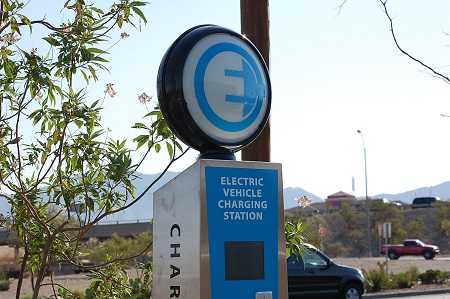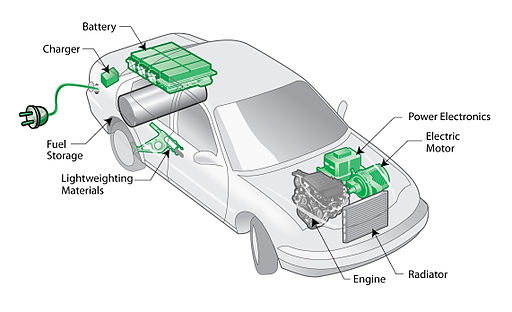Conventionally, electric vehicles are charged by plugging in the battery compartment to an outlet using a heavy duty wire. Recent work and study into inductive power transfer methods have shown that it is possible to power electric cars wirelessly. The work highlights the success achieved in charging car batteries by retrofitting them with inductive power hardware and compares the improved results with conventional charging methods. With this method, it is believed that electric cars can be made a more compelling alternative to gasoline-powered cars as a result of increased range and the nearly harmless effects of driving electric cars on a daily basis.
Introduction
The world of wireless has thrust us into the 21st century. Wireless is the crux of convenience that will help us keep pace with the today’s dynamic, fast-paced culture [1]. Conventional data transfer and electronic powering, which are accomplished with hardwire contact, have come a long way; most people now use the wireless adapter installed within their laptops to connect to the internet. Other instances of wireless data transfer include using Bluetooth technology to transfer music and pictures from one device to another as well as household electronic devices like phones, keyboards and kitchen appliances that use inductive technology to wirelessly charge their batteries.
The average commuter drives a car that runs on gasoline, diesel, or electricity. Vehicles that operate on fuel obtained from crude oil extracts have a relatively long range. However, U.S. dependence on foreign oil and the environmental effects of burning fossil fuels are major concerns that need to be addressed [3]. As a result, the engineering world is transforming automobiles from internal combustion engine (ICE) vehicles to hybrid electric vehicles (HEV) and electric vehicles (EV) [2]. Unfortunately, there is an issue of range limitation in the development of electric vehicles: the limited capacity of the Nickel Cadmium and Lithium Ion batteries are particular stumbling blocks [4]. Furthermore, current re-charging methods are slow and inefficient and are restricted to charging stations like the one in Fig. 1. The best method to overcome these restricting obstacles as well as to have more environmentally friendly vehicles is the implementation of inductive power transfer mechanisms on electric vehicles and the improvement of infrastructure to complement these applications.
Unlike Wi-Fi and Bluetooth, the term “wireless” is different when used for charging. Inductive Power Transfer (IPT), commonly known as wireless charging, is the ability to manipulate an electromagnetic field in order to transfer energy over a short distance between two objects (a transmitter and receiver) [1]. A typical apparatus for charging includes a housing that includes a lower surface, which serves as the charging surface, and a secondary inductive coil, which picks up the electromagnetic field. The charging surface usually holds a device that contains a rechargeable battery. The charging apparatus also has a controller for driving an oscillator, which allows control over the power flow to the system.
The main driving force behind inductive charging is the use of electromagnetic energy [1]. When a helix-shaped coil of wire is subject to an alternating current at high frequencies, a magnetic field is induced around the coil. The strength of the field decreases according to the inverse square law (decreasing proportionally to the square of the separation distance). And when a similar coil is placed near the current-carrying coil, the magnetic fields induce a current in the new coil, thus providing power to whatever device is attached to the new coil. Energy transferred between the inductive charging platform and the secondary inductive coil is possible because of the use of electromagnetic energy.
Charging Vehicles Wirelessly
Being able to charge vehicles wirelessly requires the implementation of dedicated infrastructures. With inductive charging, energy is transferred wirelessly to the car’s battery via a charging plate that is connected to the electricity grid buried in the road surface [5]. Typically, any electric car that has the capability to charge wirelessly will have a charging plate added to its battery setup. The entire charging apparatus has two components: a high-frequency generator—which converts main voltage of 240VAC at 50-60Hz into a high-frequency current above 20 kHz—and the magnetic coupling, consisting of transmitter and receiver pads, which are mounted in the ground and the car respectively [4]. The pads can be 100 to 300 millimeters apart, as precise alignment of the pads is not needed for charging [4]. The charging process is controlled by smart electronics that automatically start charging once the driver specifies the charge rate [4].
Charging the battery from an entirely discharged state would take about an hour and twenty minutes [5]. This is far more efficient compared to the five to eight hours required for plug-in charging. The driver would have to park the electric car overnight plugged in or all throughout the day at his or her place of work; assuming there are charging stations available. The shortest charge time recorded by a plug in charger is 3 hours through hardware that only applies to the Tesla Roadster [6]; this is the fastest way to charge while plugged, but the speed is not very impressive when compared to the results obtained through wireless charging, which is still in developmental stages.
Why Inductive Charging?
Electric cars are still more expensive than conventional ICE vehicles. The high initial cost of electric cars can largely be attributed to the limitations of battery technology [2]. Most of an electric car’s weight is due to its battery, as pictured in Fig. 2. The lithium-ion batteries, furthermore, are expensive to manufacture and purchase. Consequently, researchers are investigating new techniques to reduce the battery storage required for electric vehicles.
One idea is roadway electrification, wherein power is transferred to the vehicle as it moves along an electrified section of pavement [2]. This may seem like a monumental task, but while U.S. interstate highways make up only 1% of roadway miles, 22% of all miles travelled are on the interstate [2]. If installed here, electric vehicles may function satisfactorily with smaller battery sizes, making these electric vehicles more affordable than those that use stand-in (parked) charging.
Possibilities for Public Transit
This idea could be even more applicable if implemented in public transit systems. Buses like the one in Fig. 3 travel along the same path every time, and many are either fueled by liquid natural gas or are hybrid electric vehicles [3]. The effects of burning natural gas have a less damaging effect on the environment than burning gasoline, but it is possible to have zero emissions by switching to electric power. A research group at Waseda University in Tokyo, Japan has integrated the induction power system to an advanced Electric Micro bus [7]. The bus has achieved significant reductions in weight and initial cost by mounting only the necessary batteries and recharging at a terminal at the end of each trip [7]. With inductive technologies, buses that charge at the end of their routes (or even those that are charged on the routes themselves) could have a transformative effect on public transit.
Inductive charging methods, if successfully implemented, require very little maintenance; the components of the inductive power system are completely encapsulated, decreasing their chances of deterioration [3]. Due to this feature, the cost of maintenance should decrease. It is also possible to use the charging method in spite of sleet, snow and rain, making it adaptable to all seasons [3]. For these reasons, buses charged wirelessly may be more cost-effective than current buses powered by the combustion of liquid natural gas or gasoline.
Despite these advantages, there is a lack of knowledge on the effects of magnetic radiation to a user’s health [7]. If research demonstrates that the magnetic field produced from the inductive power system is strong enough to cause physiological harm, it could prove to be a big enough obstacle to permanently halt the development of these charging methods.
Conclusion
Research in inductive technology proves to be a promising endeavor. Some useful and interesting ideas have been proposed that may revolutionize the future of electric vehicles and perhaps the whole automotive and transportation industry. Electric cars themselves are not a low-carbon solution: the electricity used to power these vehicles has to be of low-carbon origin. Unfortunately, the U.S. is still dependent on coal-fired power plants for this electricity, but due to electric vehicles’ convenience and environmental advantages, clean energy manufacturers will hopefully get more attention and access to mainstream markets in the future. In either case, inductive power technologies may soon provide unprecedented efficiency for electric vehicle use.






